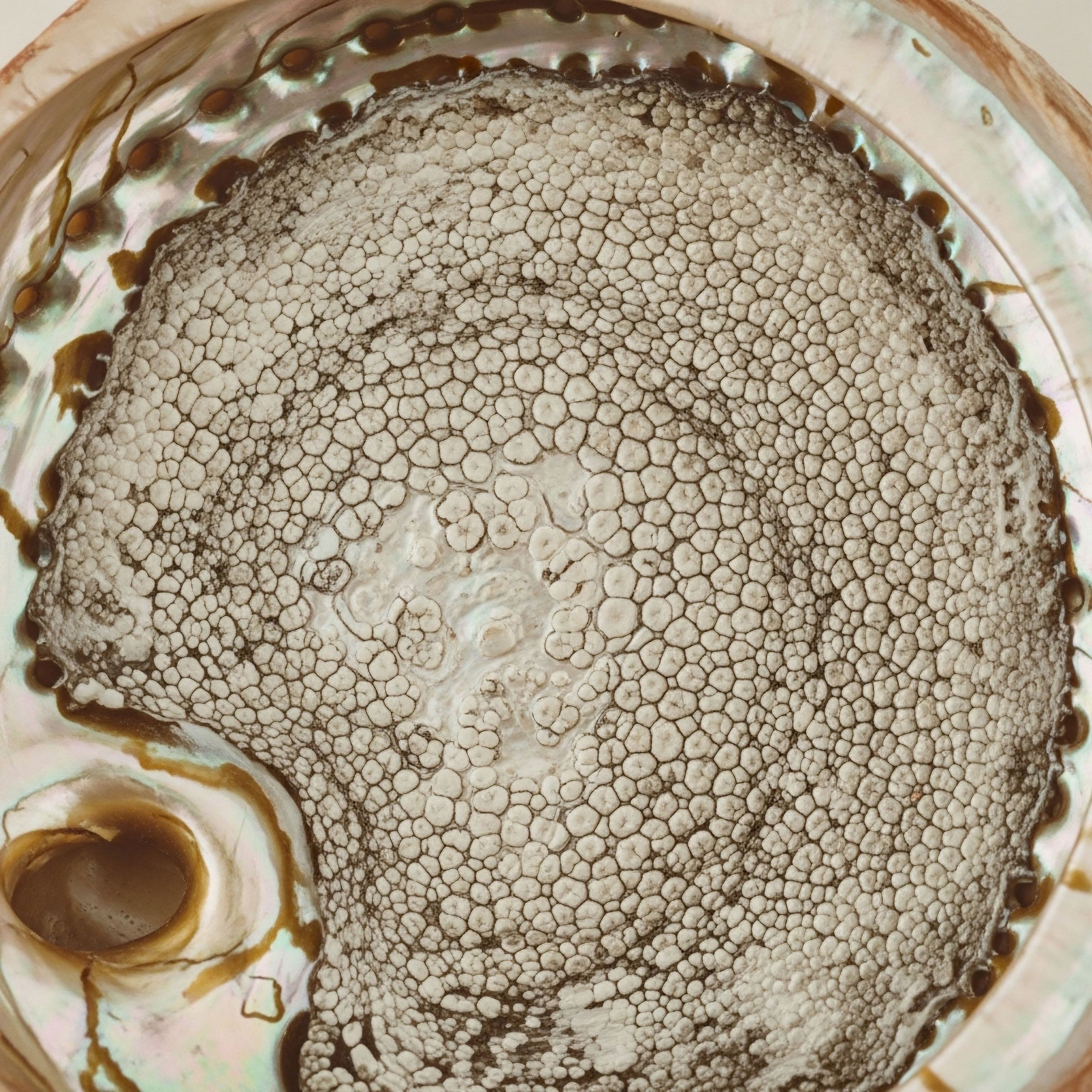

Fundamentals
The conversation about national metabolic health often centers on broad strokes ∞ population-wide dietary guidelines, public exercise initiatives, and screening programs for conditions like type 2 diabetes. These are vital components of public health, forming a necessary defensive line against a rising tide of metabolic dysfunction. Your personal experience, however, is likely far more specific.
It is felt in the persistent fatigue that clouds your afternoons, the subtle but steady accumulation of visceral fat around your midsection, or the mental fog that makes sharp focus a challenge. These lived realities, while part of a national trend, are deeply individual. They originate from the unique biochemical environment within your own body, an environment governed by the intricate communication of your endocrine system.
This is where the concept of personalized hormonal protocols enters the discussion, offering a complementary layer of precision to broad public health strategies. Your body operates on a sophisticated internal messaging service. Hormones are the chemical messengers, dispatched from glands to travel through the bloodstream and deliver specific instructions to cells and organs.
They regulate everything from your sleep-wake cycle and your stress response to your appetite and how your body utilizes and stores energy. When these messages are transmitted clearly and in the correct volume, the system functions with remarkable efficiency. With age, environmental exposures, and lifestyle factors, the production of these messengers can decline or become dysregulated, leading to miscommunication within the system. The result is a cascade of effects that you perceive as symptoms of declining vitality.

The Endocrine System Your Body’s Internal Network
To understand how personalized protocols can work, one must first appreciate the system they aim to support. The endocrine system is a network of glands, including the pituitary, thyroid, adrenals, pancreas, and gonads (testes in men, ovaries in women).
These glands produce and release hormones in response to signals from the brain, primarily the hypothalamus and pituitary gland, which form the central command center. This entire structure operates on a system of feedback loops, much like a thermostat in a home. When a hormone level drops too low, a signal is sent to produce more.
When it rises too high, a signal is sent to slow production. This self-regulating mechanism is designed to maintain a state of dynamic equilibrium known as homeostasis.
Metabolic health is directly tied to this hormonal equilibrium. For instance:
- Insulin, a hormone produced by the pancreas, instructs your cells to take up glucose from the blood for energy. When cells become resistant to insulin’s message, blood sugar levels rise, a hallmark of metabolic syndrome and type 2 diabetes.
- Cortisol, a primary stress hormone from the adrenal glands, can influence blood sugar, appetite, and fat storage. Chronic stress leads to chronically elevated cortisol, which can disrupt metabolic balance.
- Thyroid hormones act as the body’s metabolic throttle, regulating the speed at which your cells burn energy. Insufficient thyroid hormone slows down metabolism, leading to weight gain and fatigue.
- Sex hormones like testosterone and estrogen have profound metabolic roles. They influence muscle mass, fat distribution, and insulin sensitivity. Their decline during andropause and menopause is a significant contributor to age-related metabolic decline.

Why a Personalized Approach Matters
National health strategies, by their very nature, are designed for the “average” person. They cannot account for the vast genetic and lifestyle-driven variability among individuals. Your specific hormonal profile is unique. The rate at which your testosterone levels decline, how your body responds to stress, or your genetic predisposition to insulin resistance are all individual factors.
A personalized hormonal protocol begins with quantifying this individuality through comprehensive lab testing. It moves beyond a simple “normal” or “abnormal” diagnosis to interpret your specific levels in the context of your symptoms, age, and wellness goals.
A personalized protocol views your symptoms not as isolated problems, but as downstream consequences of upstream hormonal imbalances.
This approach seeks to restore the integrity of your body’s internal communication system. By correcting specific hormonal deficiencies or excesses, the goal is to re-establish the physiological environment that supports optimal metabolic function. It addresses the root biochemical drivers of your symptoms, complementing the broader lifestyle recommendations of national strategies with a targeted, molecular-level intervention. This creates a powerful synergy, where public health advice provides the foundation and personalized medicine provides the specific tools to build upon it.


Intermediate
Moving from the foundational understanding of hormonal influence on metabolism, we arrive at the clinical application ∞ the specific protocols designed to restore biochemical balance. These interventions are built upon a detailed diagnostic process that maps an individual’s unique endocrine profile.
The objective is to use bioidentical hormones and targeted peptides to restore physiological signaling, thereby addressing the root causes of metabolic dysregulation and associated symptoms. The protocols are precise, data-driven, and tailored to the distinct needs of male and female physiology.

Protocols for Male Hormonal and Metabolic Optimization
For many men, the gradual decline of testosterone starting in their 30s and 40s, often termed andropause, is a primary driver of metabolic disruption. This is characterized by loss of muscle mass, increased visceral adiposity, insulin resistance, fatigue, and cognitive decline. A comprehensive protocol for men addresses this decline directly while managing the downstream effects of the therapy.

Testosterone Replacement Therapy the Core Intervention
The cornerstone of male hormonal optimization is Testosterone Replacement Therapy (TRT). The goal is to restore serum testosterone levels to the optimal range of a healthy young adult male, typically alleviating symptoms of hypogonadism. A standard, effective protocol involves weekly intramuscular injections of Testosterone Cypionate.
However, administering testosterone alone is an incomplete strategy. The body’s endocrine system is interconnected, and introducing exogenous testosterone triggers several feedback loops that must be managed for safety and efficacy. This leads to the inclusion of ancillary medications:
- Gonadorelin ∞ When the body receives external testosterone, the brain’s pituitary gland reduces its signal ∞ Luteinizing Hormone (LH) ∞ that tells the testes to produce their own testosterone. This can lead to testicular atrophy and reduced fertility. Gonadorelin is a synthetic version of Gonadotropin-Releasing Hormone (GnRH). Administered via subcutaneous injection typically twice a week, it directly stimulates the pituitary to continue releasing LH, thereby maintaining natural testicular function and testosterone production. This preserves testicular size and supports fertility for men who desire it.
- Anastrozole ∞ Testosterone can be converted into estradiol (a form of estrogen) via an enzyme called aromatase. While men need some estrogen for bone and cognitive health, elevated levels from TRT can cause side effects like water retention, moodiness, and gynecomastia (male breast tissue development). Anastrozole is an aromatase inhibitor. Taken as a small oral tablet, usually twice a week, it blocks the aromatase enzyme, controlling the conversion of testosterone to estrogen and maintaining a healthy testosterone-to-estrogen ratio.
- Enclomiphene ∞ In some cases, Enclomiphene may be used. It is a selective estrogen receptor modulator (SERM) that can block estrogen’s negative feedback at the pituitary, thereby increasing the output of LH and Follicle-Stimulating Hormone (FSH), which stimulates both testosterone and sperm production.
Effective TRT is a carefully managed symphony of medications designed to replicate and support the body’s natural hormonal axis.
This multi-faceted approach ensures that while testosterone levels are optimized, the rest of the endocrine system remains in a state of controlled balance, maximizing therapeutic benefits while minimizing potential side effects.

Protocols for Female Hormonal and Metabolic Balance
A woman’s hormonal journey, particularly through perimenopause and menopause, is marked by fluctuations and eventual decline in estrogen, progesterone, and testosterone. These changes are directly linked to metabolic shifts, including increased insulin resistance, changes in fat distribution, and loss of bone density. Protocols for women are nuanced, addressing the interplay between these key hormones.

Hormone Therapy for Peri and Post-Menopause
While estrogen and progesterone replacement are foundational for managing many menopausal symptoms like hot flashes and sleep disruption, the role of testosterone is critically important for metabolic health, libido, and vitality.
A typical protocol for a woman might include:
- Testosterone Cypionate ∞ Women produce testosterone, and it is vital for muscle mass, energy, and sexual function. Female protocols use much lower doses than male protocols, typically administered as a weekly subcutaneous injection of 10-20 units (0.1-0.2ml of a 200mg/ml solution). This small dose is enough to restore physiological levels, improving energy, mood, and libido without causing masculinizing side effects.
- Progesterone ∞ For women with a uterus, progesterone is essential to protect the uterine lining when taking estrogen. It also has calming effects and can improve sleep quality. It is prescribed based on menopausal status, either cyclically for perimenopausal women or continuously for postmenopausal women.
- Pellet Therapy ∞ An alternative delivery method involves implanting small, long-acting pellets of testosterone (and sometimes estradiol) under the skin. These pellets release a steady dose of hormones over several months. Anastrozole may be co-administered if estrogen conversion is a concern.
The decision between injections and pellets, and the precise dosing of each hormone, is based on extensive lab work and a continuous dialogue about the patient’s symptomatic response.
| Component | Typical Male Protocol | Typical Female Protocol |
|---|---|---|
| Primary Hormone | Testosterone Cypionate (e.g. 100-200mg/week) | Testosterone Cypionate (e.g. 10-20mg/week) |
| Administration | Intramuscular Injection | Subcutaneous Injection or Pellets |
| Ancillary Medications | Gonadorelin (to maintain testicular function), Anastrozole (to control estrogen) | Progesterone (if uterus is present), possibly Anastrozole with pellets |
| Primary Goals | Restore energy, muscle mass, libido; improve metabolic markers | Restore libido, energy, mood; complement estrogen/progesterone therapy |

Growth Hormone Peptide Therapy a Complementary Strategy
Beyond sex hormones, another critical component of metabolic health is Growth Hormone (GH). GH plays a key role in body composition, promoting muscle growth and fat breakdown. Its production declines steadily with age. Instead of replacing GH directly, which can have significant side effects, a more sophisticated approach uses peptide therapies.
Peptides are short chains of amino acids that act as signaling molecules. Specific peptides, known as secretagogues, can stimulate the pituitary gland to produce and release its own GH in a natural, pulsatile manner.
Commonly used peptides include:
- Sermorelin ∞ A 29-amino acid peptide that is an analog of Growth Hormone-Releasing Hormone (GHRH). It directly stimulates the pituitary’s GHRH receptors.
- Ipamorelin / CJC-1295 ∞ This is a popular combination. Ipamorelin is a GH secretagogue that mimics the hormone ghrelin, stimulating GH release through a different pathway. CJC-1295 is a GHRH analog with a longer half-life, providing a sustained signal. Using them together stimulates the pituitary through two different mechanisms, leading to a more robust and synergistic release of natural GH.
- Tesamorelin ∞ A potent GHRH analog specifically studied and approved for reducing visceral adipose tissue in certain populations.
These peptides are typically self-administered via small, subcutaneous injections at night, mimicking the body’s natural rhythm of GH release during deep sleep. By enhancing the body’s own GH production, these therapies can improve body composition, enhance recovery from exercise, and deepen sleep quality, all of which are foundational to robust metabolic health.


Academic
A sophisticated analysis of personalized hormonal protocols requires moving beyond symptom management to examine the molecular mechanisms that link the endocrine system to metabolic pathology. The decline in anabolic hormones like testosterone and growth hormone is a central event in the aging process.
This decline is a potent driver of the cluster of conditions known as metabolic syndrome ∞ central obesity, insulin resistance, dyslipidemia, and hypertension. By dissecting the interplay between the Hypothalamic-Pituitary-Gonadal (HPG) axis and key cellular metabolic pathways, we can construct a robust scientific rationale for how personalized hormonal restoration can complement and enhance national public health strategies aimed at preventing metabolic disease.

The HPG Axis as a Primary Regulator of Metabolic Homeostasis
The Hypothalamic-Pituitary-Gonadal (HPG) axis is the primary neuroendocrine circuit governing reproduction. However, its influence extends deeply into somatic and metabolic regulation. The hypothalamus secretes Gonadotropin-Releasing Hormone (GnRH) in a pulsatile fashion, which stimulates the anterior pituitary to release Luteinizing Hormone (LH) and Follicle-Stimulating Hormone (FSH). In men, LH acts on the Leydig cells of the testes to produce testosterone. This testosterone then exerts negative feedback on both the hypothalamus and pituitary to self-regulate the axis.
With aging, a multifactorial process involving both central (pituitary) and peripheral (gonadal) decline leads to a progressive state of hypogonadism. This reduction in circulating testosterone has profound and predictable metabolic consequences. Testosterone is a powerful anabolic hormone that directly influences body composition.
It promotes myogenesis (muscle protein synthesis) and inhibits adipogenesis (the formation of fat cells), particularly in the visceral depot. The loss of testosterone, therefore, directly facilitates sarcopenia (age-related muscle loss) and the accumulation of visceral adipose tissue (VAT).
The accumulation of visceral fat is a metabolically active process that drives systemic inflammation and insulin resistance.
VAT is not merely a passive storage site for energy. It is an active endocrine organ that secretes a host of pro-inflammatory cytokines (e.g. TNF-α, IL-6) and adipokines that impair insulin signaling.
This creates a vicious cycle ∞ low testosterone promotes VAT accumulation, and the inflammatory environment created by VAT can further suppress HPG axis function and reduce insulin sensitivity in peripheral tissues like muscle and liver. This mechanism provides a clear biological pathway linking age-related hypogonadism directly to the development of insulin resistance and type 2 diabetes.

How Does Testosterone Restoration Impact Cellular Metabolism?
Restoring testosterone to youthful physiological levels via a well-managed TRT protocol directly intervenes in this pathological cycle. The benefits are mediated through several molecular mechanisms:
- Improved Body Composition ∞ Testosterone directly stimulates androgen receptors in muscle satellite cells, promoting their proliferation and differentiation into mature muscle fibers. Simultaneously, it inhibits the differentiation of pre-adipocytes into mature fat cells. The net effect is an increase in lean body mass and a reduction in fat mass, particularly VAT. This shift in body composition is a primary driver of improved metabolic health.
- Enhanced Insulin Sensitivity ∞ Muscle is the primary site of insulin-mediated glucose disposal. By increasing muscle mass, TRT expands the body’s capacity to clear glucose from the bloodstream. Furthermore, testosterone has been shown to directly improve insulin signaling within muscle cells, potentially by upregulating the expression of key components of the insulin signaling cascade, such as the glucose transporter type 4 (GLUT4).
- Reduced Systemic Inflammation ∞ By reducing the volume of VAT, TRT decreases the secretion of pro-inflammatory cytokines. This reduction in the chronic, low-grade inflammatory state associated with metabolic syndrome can improve the function of multiple organ systems, including the vascular endothelium and the liver.
| Metabolic Component | Effect of Low Testosterone | Mechanism of TRT Intervention |
|---|---|---|
| Visceral Adiposity | Increased accumulation | Inhibits adipocyte differentiation, promotes lipolysis. |
| Insulin Resistance | Increased | Increases muscle mass (glucose disposal site), improves cellular insulin signaling. |
| Dyslipidemia | Elevated Triglycerides, Low HDL | Improves lipid metabolism, often leading to lower triglycerides and increased HDL. |
| Inflammation | Elevated C-Reactive Protein (CRP), TNF-α | Reduces visceral fat mass, thereby lowering the source of inflammatory cytokines. |

The Synergistic Role of Growth Hormone Secretagogues
The age-related decline in the somatotropic axis (the GHRH-GH-IGF-1 axis) runs parallel to the decline in the HPG axis and compounds its metabolic consequences. Growth Hormone (GH) is a potent lipolytic agent, meaning it stimulates the breakdown of fats, and it works in concert with testosterone to maintain lean body mass. The use of Growth Hormone Secretagogues (GHS) like the combination of CJC-1295 and Ipamorelin represents a sophisticated strategy to restore more youthful GH pulsatility.
This combination is particularly effective because it targets two separate receptor systems in the pituitary gland:
- CJC-1295 is a GHRH analog that binds to the GHRH receptor, providing a strong, sustained signal for GH synthesis and release.
- Ipamorelin is a ghrelin mimetic that binds to the GHSR-1a receptor. This is a separate pathway that also potently stimulates GH release.
By stimulating the pituitary through two distinct pathways, the resulting GH pulse is more robust and physiological than what could be achieved with either peptide alone. This enhanced GH output contributes to metabolic health by promoting lipolysis (especially of VAT), increasing lean mass, and improving sleep quality, which itself has profound benefits for insulin sensitivity and hormonal regulation.
The restoration of both the gonadal and somatotropic axes creates a powerful anabolic and metabolically favorable environment that directly counteracts the catabolic and pro-inflammatory state of aging.

Could National Strategies Incorporate Biomarker Screening?
From a public health perspective, national strategies focus on population-level risk reduction through lifestyle modification. Personalized hormonal protocols offer a complementary, high-precision approach for individuals in whom metabolic dysfunction is clearly driven by endocrine decline.
A future, more integrated model of healthcare might see national guidelines recommending not just cholesterol and glucose screening, but also screening for key hormonal markers like total and free testosterone in middle-aged men and women presenting with symptoms of metabolic syndrome. This would allow for the earlier identification of individuals who would most benefit from personalized interventions, creating a more effective, two-tiered system for promoting lifelong metabolic health.

References
- Bhasin, S. et al. “Testosterone Therapy in Men with Hypogonadism ∞ An Endocrine Society Clinical Practice Guideline.” The Journal of Clinical Endocrinology & Metabolism, vol. 103, no. 5, 2018, pp. 1715 ∞ 1744.
- Kelly, D. M. and Jones, T. H. “Testosterone and Obesity.” Obesity Reviews, vol. 16, no. 7, 2015, pp. 581 ∞ 606.
- Davis, S. R. et al. “Testosterone for Low Libido in Postmenopausal Women ∞ A Systematic Review and Meta-analysis.” The Lancet Diabetes & Endocrinology, vol. 7, no. 12, 2019, pp. 942-950.
- Sigalos, J. T. and Pastuszak, A. W. “The Safety and Efficacy of Growth Hormone Secretagogues.” Sexual Medicine Reviews, vol. 6, no. 1, 2018, pp. 45-53.
- Walker, R. F. “Sermorelin ∞ a better approach to management of adult-onset growth hormone insufficiency?” Clinical Interventions in Aging, vol. 1, no. 4, 2006, pp. 307-308.
- Traish, A. M. “Testosterone and weight loss ∞ the evidence.” Current Opinion in Endocrinology, Diabetes and Obesity, vol. 21, no. 5, 2014, pp. 313-322.
- Rochira, V. et al. “Testosterone in the new millennium ∞ a new look at an old hormone.” Journal of Endocrinological Investigation, vol. 36, no. 9, 2013, pp. 764-775.
- Saad, F. et al. “Long-term treatment of hypogonadal men with testosterone produces substantial and sustained weight loss.” Obesity, vol. 24, no. 4, 2016, pp. 779-786.
- Leder, B. Z. et al. “Effects of aromatase inhibition in elderly men with low or borderline-low serum testosterone levels.” The Journal of Clinical Endocrinology & Metabolism, vol. 89, no. 3, 2004, pp. 1174-1180.
- Korljan, B. et al. “The impact of hormone replacement therapy on metabolic syndrome components in perimenopausal women.” Medical Hypotheses, vol. 74, no. 1, 2010, pp. 162-3.

Reflection
The information presented here provides a map of the intricate biological landscape that governs your vitality. It connects the feelings of fatigue, the changes in your body, and the shifts in your mental clarity to a tangible, measurable system of internal communication.
Understanding these connections is the first, most meaningful step toward reclaiming agency over your own health. The science of endocrinology and metabolism is complex, yet its core principles are logical. Your body is a system striving for balance, and the symptoms you experience are its signals that this balance has been disturbed.
This knowledge transforms the health journey from a passive experience of enduring symptoms into an active process of investigation and restoration. The question of how to move forward is deeply personal. It involves reflecting on your own experiences and goals. What does optimal function feel like to you?
What aspects of your vitality do you wish to restore and protect? The path forward is one of partnership ∞ between you and a clinical team that listens, measures, and helps translate your personal health narrative into a precise, data-driven strategy. The potential for a vibrant, functional life does not diminish with age; it simply requires a more sophisticated and personalized approach to maintain.



